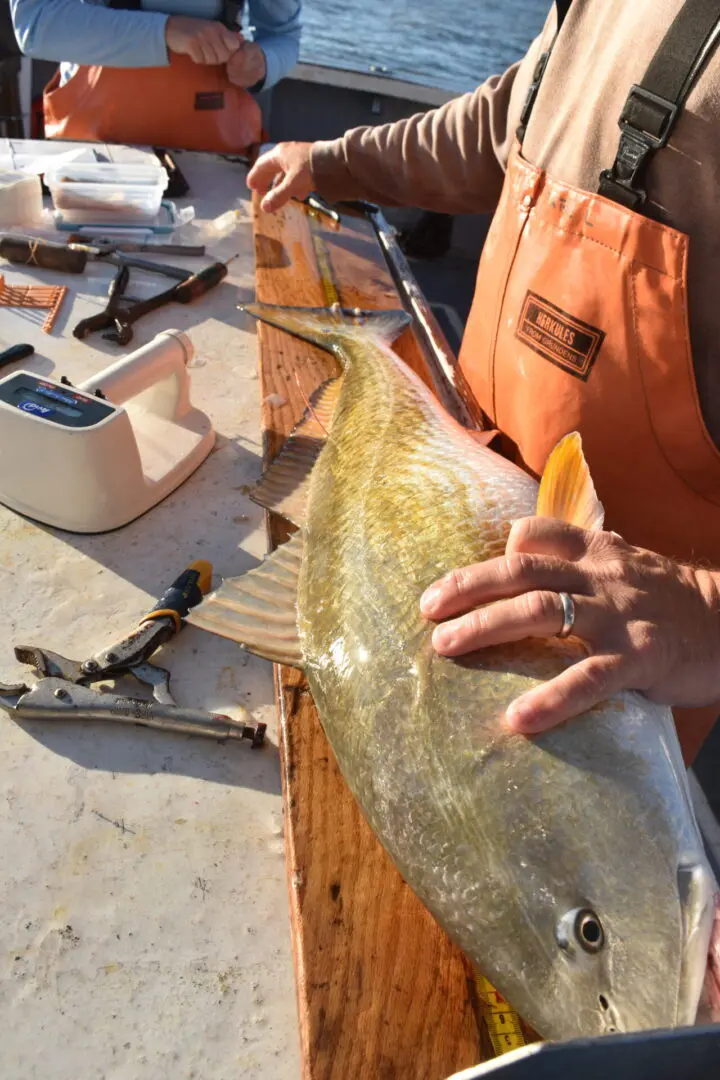Gag Grouper
Gag Grouper, Mycteroperca microlepis, is a large, slow-growing, protogynous hermaphrodite found on both inshore and shelf-break reef habitats, generally at depths less than 300 ft. Their full range covers the western North Atlantic, from New York to Brazil, and in the Gulf of Mexico.
Gag Grouper are popular for recreational and commercial fishing. The most recent stock assessment in the South Atlantic found Gag Grouper were overfished and overfishing was occurring, so a recovery plan involving spawning season closure, minimum size limits, bag or trip limits, and annual catch limits was adopted.
The Southeast Reef Fish Survey collects data on Gag Grouper abundance, distribution, length, age, and reproduction. Some select examples of data uses for this species includes:
- SEDAR71: Gag Grouper
- Keilin R Gamboa-Salazar, David M Wyanski, Walter J Bubley, Nikolai Klibansky, Effects of age and size on spawning and egg production in gag and scamp grouper off the southeastern United States, ICES Journal of Marine Science, Volume 77, Issue 1, January-February 2020, Pages 290–299, https://doi.org/10.1093/icesjms/fsz174

Coastal Sharks
The estuaries of the Southeast U.S. and nearshore waters are used by various shark species as nursery grounds. For example, the scalloped hammerhead, Sphyrna lewini, can be found throughout the Atlantic Basin, generally in warm, coastal waters, with juveniles and adults using marine and estuarine areas and the Carolina hammerhead, Sphyrna gilberti, is a newly described species (2013!) whose broader distribution and biology is still under investigation. Hammerheads and many other shark species are monitored by the Coastal Longline Surveys, which continue to collect data such as distribution, abundance, total length, fork length, weight, and tag release data for these species. As most shark species are slow growing with long reproductive cycle, they can be vulnerable to overfishing. Thus, management is important to the long-term sustainability of coastal shark recreational fisheries.
Data from these surveys have been used for management for decades. Some select examples of recent data uses for these species include:
- ASMFC Annual Compliance Report
- SEDAR65: Blacktip
- SEDAR77: Great and Scalloped Hammerhead
- SEDAR21: Blacknose and Sandbar
- SEDAR34: Atlantic Sharpnose and Bonnethead
- SEDAR54: Sandbar
- Abundance and distribution used in a petition to NOAA to have the Scalloped Hammerhead segment in the Atlantic listed under the Endangered Species Act

Spanish Mackerel
Spanish Mackerel, Scomberomorus maculatus, is a wide-ranging, pelagic species found in shallow waters (<40 ft) along the U.S. east coast from Florida to Maine. Spanish Mackerel are gonochorists (separate sexes) that spawn from April to September throughout their Atlantic range.
Spanish Mackerel are popular for both recreational and commercial fishing. The most recent stock assessment in the South Atlantic found that the stock was not overfished and overfishing was not occurring. Regulations used for management of this stock include minimum size limits, bag or trip limits, and annual catch limits.
The Coastal Trawl Survey collects abundance, distribution, size, and age data for juvenile Spanish Mackerel (<2 years old) in their near-coastal, soft-bottom habitats. These data can provide an estimate of potential recruitment into the adult population to allow better planning for future years.
Some select examples of recent data uses for this species includes:

